
Seachem Matrix is a “natural rock” product that is heavily marketed by Seachem as a supposedly extremely good media to be put into aquarium filters. Matrix is NOT good media for aquarium filters. It has the following shortcomings:
- Low effective surface area which gives poor biofiltration
- Sheds small abrasive particles which take out pumps
- Does not do any denitrification
- Very high cost
Ceramic media like Matrix have a huge amount of false marketing hype and snake oil salesmanship. It is all false. Matrix does NOT have huge amounts of beneficial bacteria living inside it. We go into the reason behind that in great length below. Only hobbyists who are nerds like the author need to read on. This is VERY long and boring.
Matrix in Depth
Matrixtm is a whitish-gray half-inch “natural stone” biomedia product which many hobbyists swear by. It is probably the most common media in use in the hobby. It is made by Seachem.
Note I admit that I have a “chip on my shoulder” when it comes to Seachem products. The amount of misleading and downright false marketing hype that Seachem uses for ALL its products is just nauseating. And they have threatened me with a libel suit. I do not like being threatened. Just for information purposes one cannot be sued for libel or defamation if one simply tells the truth. Which I have done in all cases.
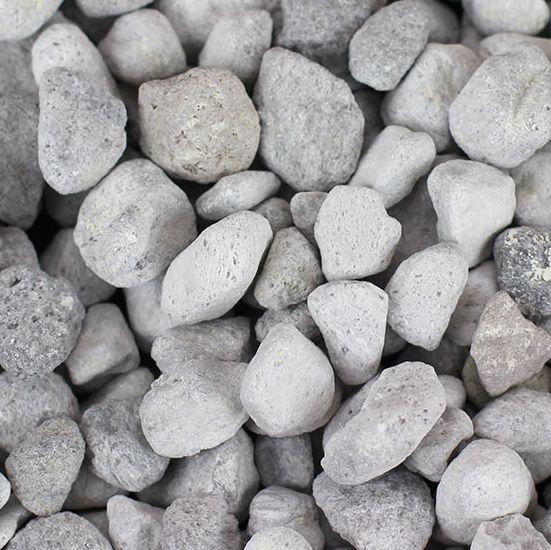
.
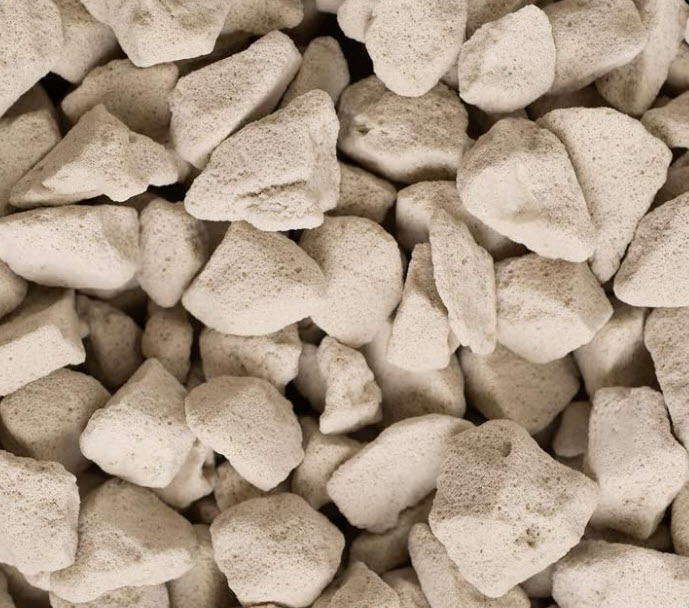
Matrix is very similar to the porous ceramic products in all its properties. It is extremely expensive with very little effective surface area (about 20 to 40 ft2/ft3).
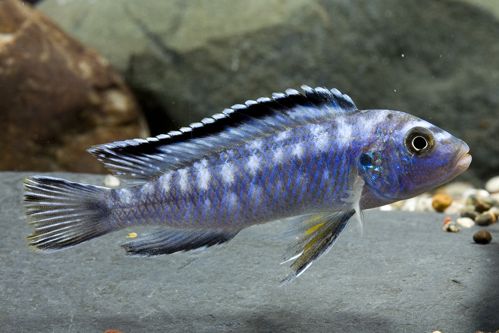
Note that it appears that Matrix was changed several years ago. Years ago Matrix was obviously pumice, a type of volcanic rock which doesn’t absorb water and floats. Matrix of old had variable composition stones in it and obviously was mined from a rock pit. The MSDS (material safety data sheet) for Matrix identified it as Pumice.
The new Matrix is identical in appearance (under a microscope!) and properties to a man-made fused glass product which used to be available in garden stores called “Growstone”. Matrix now absorbs water and sinks, just like Growstone. Hhhmmmm???
Note that one could purchase the “Growstone” material for 10% of the cost of Matrix. Also note that as of 2019 “Growstone” was renamed “Buddystone” for some reason.
There is another aquarium filter media available in some countries like India called ADA bio Rio media. This is virtually identical in all its properties to Matrix, except the product is sold wet, supposedly seeded with beneficial bacteria. This product claims to have enough beneficial bacteria on it that it can “instantly cycle” an aquarium. These claims are just marketing hype. Like Matrix, it is extremely expensive with a high profit margin. Thus every fish store in India “highly recommends” it. LOL Love the profit motive!
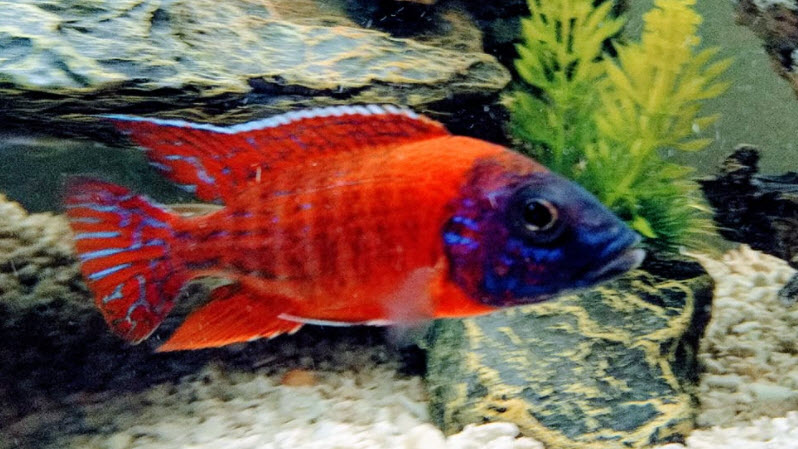
False Marketing Claims
The surface area claims made for Matrix are 700 meters per liter. This is 700,000 m2/m3 or 213,416 ft2 per ft3 of surface area. As usual with Seachem this is a mix of truth and lies, in a masterfully word smithed narrative.
Per a very complicated test called the BET nitrogen infusion test, Matrix may well have the “surface area” it claims to have. But this is incredibly misleading. This surface area claimed for Matrix is based on how much nitrogen gas can penetrate the media and adsorb on the surface via something called a pycnometer via a complex calculation called the BET equation. This test doesn’t even come close to reflecting reality in the aquarium.
Matrix has roughly 15 to 30 ft2/ft3 of EFFECTIVE surface area, confirmed by testing under actual aquarium conditions. The BET test gives 213,416 ft2 per ft3. And the math and real life testing gives 15 to 30 ft2 per ft3. How’s that for marketing hype?
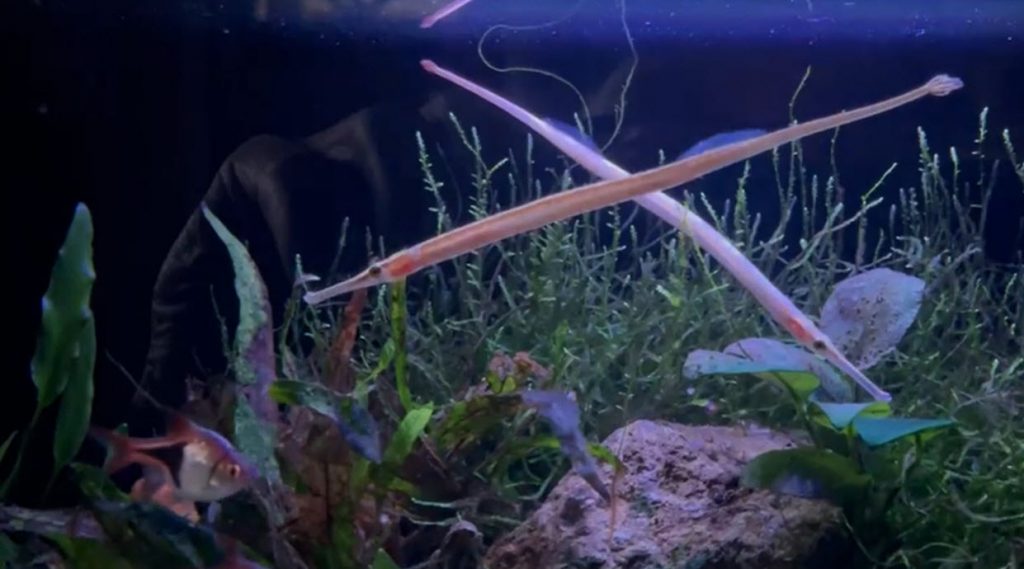
The difference here is largely due to the difference in size between a nitrogen molecule and a beneficial bacteria. The nitrogen gas molecule is billions of times smaller than a beneficial bacterial cell. So, the nitrogen gas is adsorbed in billions of tiny pores where bacteria can’t even fit. Since it is the bacteria which do the oxidation of ammonia to nitrate, Matrix is MUCH less effective than its marketing hype would indicate.
Depending on the ceramic process used, the pore size in ceramic media such as Matrix can be as low as 0.0001 microns in size. The ceramic media claiming the highest surface area have the smallest pore sizes. A bacterium is 2 to 5 microns in size. So the BET nitrogen infusion test is simply worthless in determining the surface area available for beneficial bacteria to colonize.
Also nitrifying bacteria live inside a biofilm (which they create) and that has a thickness of around 50-300 microns (let’s say 200 microns average). So, a round pore inhabited by nitrifying bacteria is coated on all its internal surface by this film. Which means that is a diameter of around 400 microns (almost half a millimeter) is occupied by bacterial biofilm. And then, enough space needs to remain for a good water flow through it. This means that a single pore needs to be larger than at least one millimeter (two is even better) in order to be efficiently occupied by nitrifying bacteria.
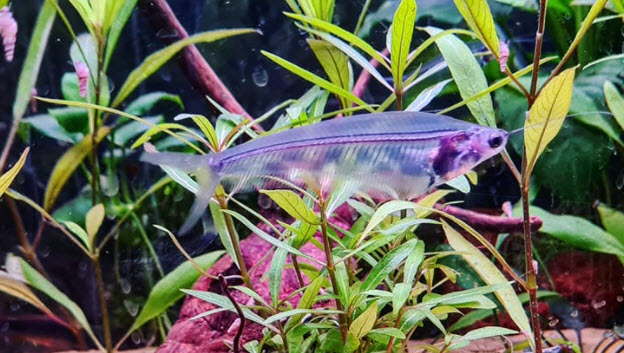
Also, let’s say Matrix with its large surface area will have a “large” pore size on the order of 30 microns (one thousandths of an inch). A bacterium is 2 to 5 microns in size. So, a bacterium only must divide a few times to clog a “large” passageway into Matrix. Bacteria can multiple every 30 minutes. Think about that for a while. Even the “large” pores are just too small. They clog far too rapidly. The actual effective surface area of Matrix after a few weeks is on the order of only 15 to 30 ft2 per ft3.
There is no way to sugar coat it. Seachem’s surface area claims are simply bogus. They are pure unadulterated marketing hype.
In any case, the other problem with Matrix has to do with flow. In order for nitrifying (ammonia oxidizing) beneficial bacteria to work there has to be a high flow over the surface of the bacteria. The flow with Matrix is around, not through the media. So the Matrix media will do a very poor job of biofiltration, even if the beneficial bacteria could somehow manage to fit into the structure of the Matrix.
The proof that beneficial bacteria do not live inside Matrix is simple. After a few months of operation beneficial bacteria turn brown. I took a piece of Matrix that had been operating in a canister for years. It was brown all around the outside. When I split it in two with a chisel the inside was pure white, with not a hint of brown. There was no bacteria inside the piece of Matrix. NONE!
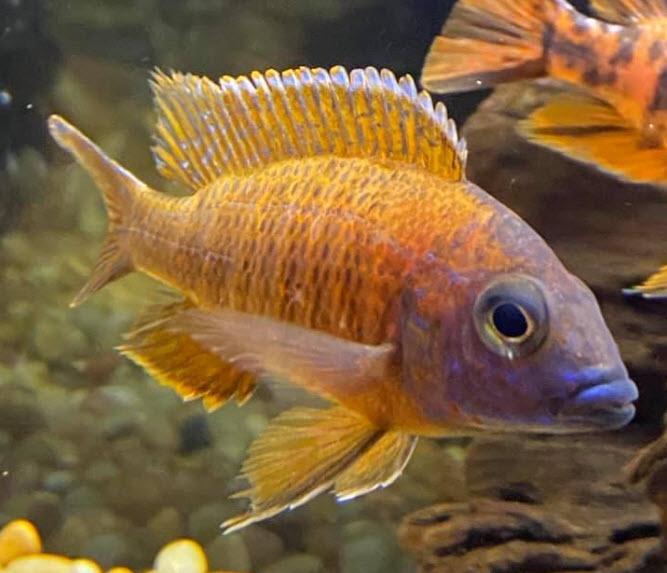
Testing Matrix
A test was run on filter media which showed Matrix had about one fifth the ammonia oxidized capability of foam on a cubic inch to cubic inch basis. It had about one fourth the capabilities of static K1 and pot scrubbers.
A test of ammonia oxidizing capability of various filter media was run. The first number, the “efficiency” is the average ammonia oxidizing that 15 cubic inches of media accomplished over a 90-day period. The second number is the “effective” surface area in square feet per cubic feet calculated from that test. The third number is the effective surface area in square feet per cubic feet calculated by simple mathematics. The correlation between the test results and the calculated surface area is very significant and means the testing was accurate.
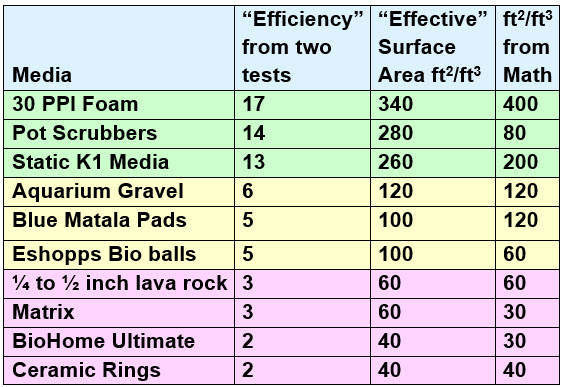
The higher the numbers here the better the media. This makes 30 ppi foam the best media and ceramic rings the worst media.
This test makes it clear that the claims of huge surface areas by Seachem are simply very misleading. But this is typical of Seachem. More details on the test can be found at this link:
7.1.3. Test of Filter Media
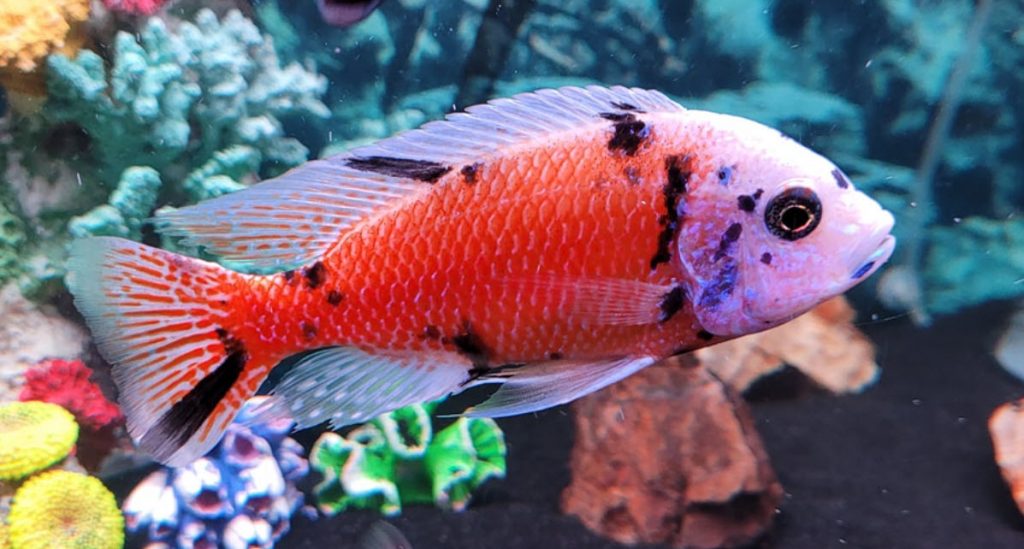
How Does Matrix Stack Up?
A comparison is in order. This table compares K1 extruded plastic media to Matrix media as static biomedia in a canister filter or sump filter.
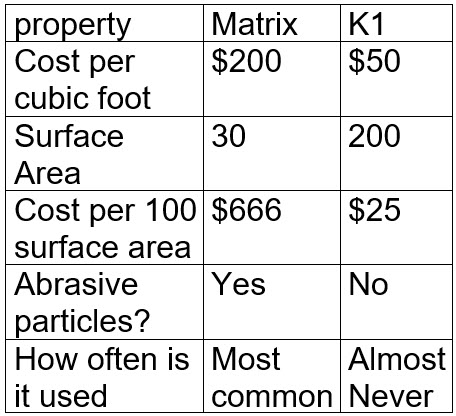
What this can translate to is illustrated by the number of fish a typical canister can handle with crystal clear water stocked with these two media:
• Static K1 media – 20 five-inch fish
• Matrix – 3 five-inch fish
So Matrix costs four times more than K1 on a volume basis and a given volume of Matrix only can handle one sixth the load of a given volume of K1. This is a difference in cost effectiveness of a factor of 24, which is huge.
Denitrification Claims
There are many “believers” in Matrix who claim that Matrix reduces nitrates in an aquarium via reduction of nitrate to nitrogen gas inside the Matrix media. Seachem “De*Nitrate” (Matrix) was tested over a period of one year and did not do any nitrate reduction. It was tested against two plastic media “controls” which couldn’t possibly do any nitrate reduction and there was NO difference in nitrate levels after a year, even though very low flow filters were included in the tests. Biocenosis baskets and BioHome were also tested and didn’t work.
This article includes an extensive analysis as to why reduction of nitrate to nitrogen gas is impossible in the aquarium for no less than six solid scientific reasons.
7.5. Test of Denitrifying Media
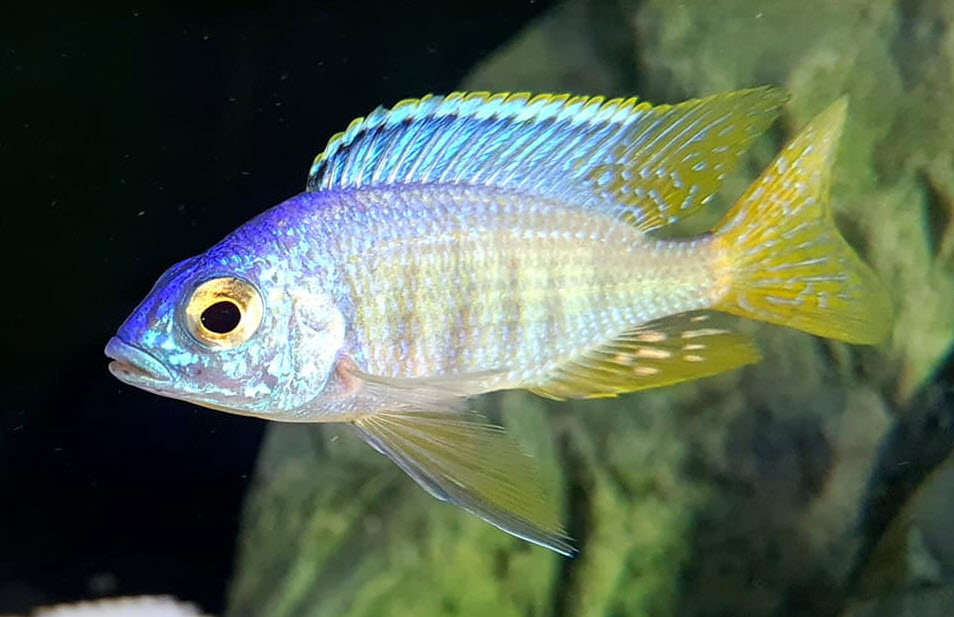
Belief Perseverance Effect
Social media response has shown that many, many hobbyists who read this analysis that have Matrix in their filters will simply reject the above testing and analysis. This is something called “belief perseverance effect”. It says that when we buy something, especially if we pay a lot of money for that something, even when presented with evidence we made our purchase in error, we tend to rationalize and support our decision. Logic and science will often have little effect on such beliefs.
.
“Nothing dies harder than a lie people want to believe,” Calvin
.
Now ignoring the science and embracing Matrix will not kill one’s fish. They will only result in what is the unnecessary expenditure of money and possibly some less than healthy fish. If one believes in Matrix, have at it! In our society burning money is completely acceptable.
.
Return to Filter Media Menu
Return to List of Filter Media Menu
.
Aquarium Science Website
The chapters shown below or on the right side in maroon lead to close to 400 articles on all aspects of keeping a freshwater aquarium. These articles have NO links to profit making sites and are thus unbiased in their recommendations, unlike all the for-profit sites you will find with Google. Bookmark and browse!
.

Dave says
In reply to Jerry …. Biohome and Seachem “De*Nitrate” (Matrix) were tested over a period of one year and did not do any nitrate reduction. They were tested against two plastic media “controls” which couldn’t possibly do any nitrate reduction and there was NO difference in nitrate levels after a year, even though very low flow filters were included in the tests. Biocenosis baskets were also tested and didn’t work. This article includes an extensive analysis as to why reduction of nitrate to nitrogen gas is impossible in the aquarium.
http://aquariumscience.org/index.php/7-5-denitrifying-media/
Jerry Shelton says
If I can add to the conversation here, the article you wrote is very correct with regard to “nitrifying bacteria.” It’s easily confirmed that nitrifying bacteria are the size you indicate, and require the water flow indicated too. It is also easily confirmed that nitrifying bacteria are an aerobic bacteria, meaning they need a decent amount of oxygen to function/survive.
The conversion of ammonia into nitrites is known as nitrification. Your article covers the nitrification process correctly. Your observable results ALSO explain why nitrification bacteria are NOT present “inside” the Seachem Matrix product.
Nitrification bacteria are almost exclusively found on the SURFACE of virtually all items in an an aquarium. The substrate, decor, etc. Most biomedia simply provide a greater surface area for these bacteria to grow “ON”. They do not grow in areas without sufficient oxygen exchange.
Interestingly, the amount of nitrifying bacteria surface required by most aquariums is FAR FAR FAR exceeded when bio media is added. It’s significant overkill, that largely protects the aquarium through massive redundancy. An aquarist may clean the entire tank, wash all the decor, wipe down the glass, etc. and there’s still MORE than enough nitrifying bacteria in the bio media to handle anything. That’s the value of adding the bio media.
If your goal is to add even more nitrifying bacteria, pretty much any of the bio media out there is more than sufficient. Noodles, lava rock, pumice, etc. They all provide more than enough surface area. Heck… a basic SPONGE filter provides more than enough surface area, even if you squeeze it out periodically.
So… if your whole premise is nitrifying bacteria, YEAH, Matrix doesn’t do anything more than any other product! But you aren’t addressing the WHOLE story, of why Matrix is a better product than other bio media. Without this information, your whole article makes it seem like Matrix is a lesser product.
Matrix makes a unique claim that is being overlooked in your article. The matrix product contains internal pores that support “anaerobic bacteria” that are DE-NITRIFYING. Yes, you read that correctly, if you’re hitting the comments section. Matrix supports bacteria that REMOVE NITRATES from the water. In addition to supporting the nitrifying bacteria on the SURFACE of the Seachem Matrix product (which accounts for the brown-looking outside you mentioned, and quickly grow, btw), Matrix also supports denitrifying bacteria. However, the TIME required to grow these bacteria is significant. It may take 6-months to a YEAR of using Matrix to see the benefits. Why? Because it takes that long to grow the anaerobic bacteria INSIDE the matrix pellets.
This is how it works:
Denitrification is the process to remove nitrates or nitrites from the aquarium water by chemical reduction. Specifically, the actions of denitrifying bacteria convert the nitrates (produced by the nitrifying bacteria) in the aquarium water to free atmospheric nitrogen. They literally REMOVE nitrates from the aquarium.
The biggest problem to solve with de-nitrification, however, is the fact that the bacteria are anaerobic, meaning they live/thrive in oxygen free or in VERY LOW oxygen environments. How in the world do you get that in an aquarium filter that is often pushing hundreds of gallons an hour of oxygenated water? The answer lies in the construction of the Matrix product. The internal pores of the Matrix product allow a small amount of water into the interior of the product, regardless of the flow OUTSIDE the pellets. This results in water reaching the inside that contains very low oxygen. The media contains zones that harbor bacteria that can break down nitrates.
Because the water flow is small, and the time taken to GROW these denitrifying bacteria is long, the rate at which you see a measurable change is signficant. You are NOT going to see a noticeable difference in nitrate production for months and months. But eventually, the Matrix product will result in denitrification of the aquarium.
But here’s the rub (and listen up aquarium people!): If you only use the amount of matrix that is required to support the NITRIFICATION process (the oxygen process), the amount of denitrifying bacteria is limited. Yes, you’ll see a drop in nitrates at the 6-month to year range… but 3-5ppm at a typical water change isn’t going to be a lot for a freshwater tank. In fact, it may gain you a day interval or so between changes. not really signficant. However, if you add MORE Matrix as part of your biomedia than the minimum required to support nitrificiation, then you obviously will get more denitrification! I have a 75 gallon cichlid tank, that has a full GALLON (4L) of Matrix in the three canister filters. After a year, it has added about a half-week of buffer to my regular water changes. I don’t do them every 6 days, like I did originally.. I’m now up to about every 10-11 days, with the same nitrate levels (and interestingly, a probable HIGHER bio-load, given the fish have grown).
Bottom line is that this article covers VERY NICELY the reason why Matrix isn’t any better than other cheaper alternatives for NITRIFICATION. What is missing is the fact that unlike Sponge filters, plastics, bio-balls, or even scrubbers that have lots of surface area… Matrix has an INTERNAL surface area that supports DENITRIFICATION.
And to see the benefits… Yeah… you have to be VERY patient… and run the stuff for 6-months to a year. There are plenty of HARD EVIDENCE videos out on Youtube that show the differences.
Again, this article is great for understanding nitrification. Kudos to the Author for writing it up… but it’s not the real reason why Seachem Matrix is so freaking amazing.
And PS… Just because your nitrates are in better control, doesn’t mean you can skimp on water changes for other reasons! 🙂
Dave says
Dan …. There are four top media, each with it’s pluses and minuses. Fluidized K1 is the “best” but requires a sump. Next is foam but it requires very careful cutting to prevent flow around. Then you have plastic pot scrubbers, which are great in small amounts but expensive in large quantities. Stationary K1 is very good but very expensive in small quantities.
Dan Blight says
So does this mean sponges are the best bio media?
Dave says
In reply to Fabrizio … Good explanation. I’ve incorporated it into the write-up. Many thanks.
Fabrizio Lattuca says
Actually it is even worse than that.
Nitrifying bacteria do not live isolated.
So, even a pore few microns large is not enough to offer a good living environment for Nitrifying bacteria a couple micron long.
Nitrifying bacteria live inside a biofilm (which they create) and that has a thickness of around 50-300 microns (let’s say 200 microns average).
So, a round pore inhabited by nitrifying bacteria is coated on all its internal surface by this film.
Which means that is a diameter of around 400 microns (almost half a millimiter) is occupied by bacterial biofilm.
And then, enough space needs to remain for a good water flow through it.
This means that a single pore needs to be larger than at least one millimiter (two is even better) in order to be efficiently accupied by nitrifying bacteria.